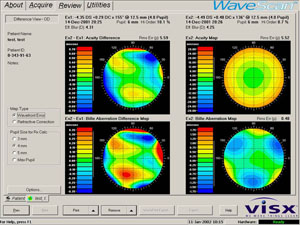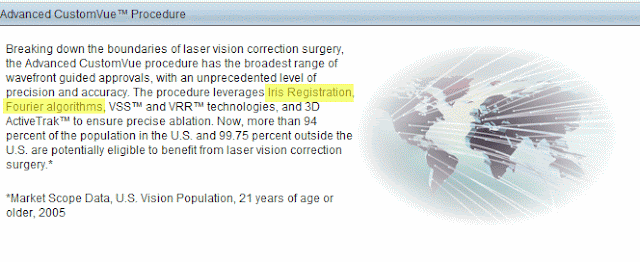Isn't it odd that I'm posting about LASIK complications
after the procedure was completed? Previously, my wife was so gung-ho about LASIK that she didn't want to
wait (or cared) about the potential complications. Luckily for her, I
actually cared and did all the research for her. Now that the procedure has been a success, I'm not sure what to do with those notes. I might as well share it here.
The first thing you need to know is that not everyone is qualified for LASIK (or PRK). This is where having a qualified and scrupulous doctor is very important, beyond just selecting the correct technology for your prescription. Ten years ago, there was a money grab with some doctors who was not always looking out for the patient's benefit. Even now, there are still cases of people who angry and upset about their quality of vision after LASIK or felt they were
mislead by their doctors. Being able to see without glasses is great, but having star-bursts, halos, and dry eyes could be debilitating.
Therefore, it's not surprising that you are now required to sign the informed consent forms that state all the potential LASIK complications. The problem with the consent form is that it doesn't tell you what, why, or if you are in a higher category of danger for having those complications. It just states that there are complications as a result of LASIK. This is why it's important that you educate yourself first so that you can can ask the proper questions to the doctor and see for yourself and understand why and if you are a good candidate rather than just relying on the doctor's yay or nay diagnosis. Only you can decide if the risks are worth it. Unfortunately, certain individuals are in a higher risk category.
Pupil Size


If you research LASIK complications on the Internet, the vast majority them are due to the doctors not informing their patients that they have larger than normal pupil and pushing them unadvised LASIK procedures. Did you watch the 20/20 special on LASIK regarding double vision, halos and star-bursts? Doctors should turn away prospective patients if they have higher than normal pupil size. The average ablation zone for the laser is 6.5mm. The average pupil size is around 6mm. If your pupil expands at night beyond the ablation zone, that's when trouble starts. Problems such as star-bursts, halos, etc occur due to to the correction zone being smaller than the size of the expanded pupil. This is why most LASIK issues with halos and star-bursts occur at night when the pupil expands. Read this to understand more about
problems with large pupils. Most modern wavefront laser attempt to fix potential night time vision issues by creating a bigger
blend zone. This may help in some cases but there is no concrete proof that blend zone resolve the problem of having large pupil size! In general, if you have larger than average or larger than the laser's
ablation zone pupil size, the doctor should turn you away. If the doctor
doesn't, your spidey senses should tingle!
Higher Order Aberrations

Large pupils are not always the cause of problems,
higher order aberrations can also be the cause of these problems. In an earlier posts, I mentioned that LASIK (and PRK) procedures
tend to create higher order aberrations. Wavefront-optimized attempt to limit that whereas wavefront-guided attempts to correct it. Your objective is always to limit higher order aberrations, especially if you already have higher order aberrations, however all LASIK laser and procedures as a by-product create some sort of higher order aberrations.
Therefore it's important to have a wavescan performed to measure the
existence and magnitude of it. My wife who had problems with higher
order aberrations was never able to achieve great vision pre-op even
with her contacts. I have 20/15 vision, but at night I see slight
starbursts that is very slight, nothing as bad as the picture shown
above. Even with my naturally excellent eye sight, I'm pretty positive
that the existing higher order aberrations in my eyes are the culprits
for the slight starbursts at night.
This is why some pay more and some pay less for their LASIK procedure. In my opinion, it's ridiculous that some surgeons even offer these as a choice for prospective patients unless they have a very slight prescription, even then I would be wary of not opting for the wavefront solution. Standard LASIK doesn't offer blending zone
which is is why some patients in the past who had standard LASIK with
average pupil size still ended up with problems of starbursts and halos. If these patients knew ahead of time that the cheaper standard LASIK laser may deliver substandard results for medium to high myopes as well as having a tendency to cause more higher order aberrations, would they choose it or opt for the more expensive option?
Dry Eyes
This is the other biggie. Most doctors today will ask you if you have existing dry eye symptoms. If you already have dry eyes, LASIK may further cause issues and you should reconsider. My cousin who did not have dry eyes pre-op had pretty bad symptoms for close to a year. My wife on the other hand had it for for the first couple days on only one eye. Five days later she is only using artificial tears every four hours or so. You never know. Chronic dry eyes could be a
very bad problem. Discuss this fully with your doctor if you have existing dry eyes or the potential of having dry eyes.
Thin Corneas
If you have thin corneas, don't be surprised if the doctor recommend only PRK for you. Early on, some doctors performed LASIK on patients without checking their cornea thickness or pushing the boundary of safety. The result for some were ecstasia due to excessively thin corneas...and of course malpractice suits for the doctors. This is why if you have thin corneas, your doctor will tell you that you are only qualified for LASIK but instead offer PRK. Did you know that there are now advancements in PRK such as
LASEK and
epi-LASEK where the recovery time is much faster than PRK? So far, I haven't seen any south bay doctors offering this version of PRK. If faster recovery time is desirable, you may want to look for a doctor who offers LASEK.
Hacks
What is a hack? That's an unqualified doctor or one who cut corners in order to save money. It can be anything from reusing microkeretome blades to pushing people to perform LASIK when they are clearly unqualified. If you are on an assembly line, with 20 patients waiting for LASIK from morning until late into the night, the doctor obviously wants to get through each of you quickly. If something as delicate as surgery is hurried, mistakes may occur either through carelessness or tiredness. For example, this one
individual waited until 10PM because the clinic overbooked. Not surprisingly, she ended up with problems. Here is this one person who had his vision ruined because the 'doctor' (who knows, this is Peru after all!) didn't
calibrate their machine properly. Or then there are cases of people who had LASIK done too soon while their
vision was still
regressing. So be very careful if the doctor offer the LASIK at an extremely cheap price, you are not able to ask questions with your doctor, you are pushed to have a procedure, you see are waiting 3-4 hours for a consultation, or you show up to your surgery but end up sitting on the floor with the waiting area looking like a refugee camp.
Are you scared yet? Well, if LASIK was that dangerous, I wouldn't have let my wife go through with it. There has been 31 million LASIK procedures performed. The number of satisfied patients outnumber the unsatisfied patients by many factor. Also, many of the complications were a result of doctors pushing unqualified individuals to have LASIK done when they were clearly not candidates for it. Nevertheless, you should still prepare yourself for the possibilities of complications. The doctors we consulted with are all well respected and are careful to screen their candidates. They have their reputation to protect and have been in business a long time for a reason. However, based on the horror stories out there, not all doctors are that conscionable.
The majority of LASIK complications I've read online are due to (a) large
pupils, (b) dry eyes, or (c) thin corneas. There are a small percentage with complications that are unrelated to the above three such as flap complications and misdiagnosis of prescription or miscalibration. It is an elective surgery and there are risks involved. Educate yourself before you go for a consultation. Question everything and do not take their answer as gospel. They may be medical doctors but they are also human. Greed sometimes cloud people's decisions.
LASIK is a miracle cure if everything goes right. As with anything involved with the human body, when things go wrong it could go very wrong. So think twice next time you go to Tijuana for the $800 LASIK. It's a decision that will affect you for better or worse for the rest of your life.
Disclaimer: This is my opinion. This should not be considered medical advice.
References:
http://www.realself.com/review/king-of-prussia-lasik-put-disability
http://www.usaeyes.org/lasik/faq/lasik-pupil-size.htm
http://www.allaboutvision.com/conditions/aberrations.htm
http://lasik-flap.com/forum/viewtopic.php?t=850
http://www.realself.com/review/new-york-terrible-pain-sleep-lasik-laser-vision-correction-surgery
http://www.allaboutvision.com/visionsurgery/lasek.htm
http://www.allaboutvision.com/visionsurgery/epi-lasik.htm
http://www.realself.com/review/lasik-brazil
http://www.realself.com/review/lasik-waist-money-canada
http://www.realself.com/review/only-last-few-years
http://www.realself.com/review/lasik-great-dont-do-it-too-young





